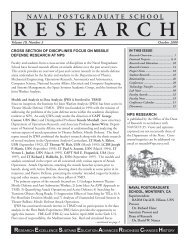Spectral Unmixing Applied to Desert Soils for the - Naval ...
Spectral Unmixing Applied to Desert Soils for the - Naval ...
Spectral Unmixing Applied to Desert Soils for the - Naval ...
Create successful ePaper yourself
Turn your PDF publications into a flip-book with our unique Google optimized e-Paper software.
LIST OF FIGURES<br />
Figure 1. The above figure shows how incident light interacts with surface materials<br />
via transmission, reflection, scattering and absorption (From Olsen, 2007). ....4<br />
Figure 2. This figure from<br />
http://www.astro.cornell.edu/academics/courses/astro201/emspectrum.htm<br />
shows <strong>the</strong> divisions of <strong>the</strong> electromagnetic spectrum. The region most<br />
often exploited by remote sensing scientists range from <strong>the</strong> ultraviolet <strong>to</strong><br />
infrared portions of <strong>the</strong> spectrum (Halvatzis, 2002, Goetz and Rowan,<br />
1981)……………… ..........................................................................................5<br />
Figure 3. From Green et al. (1998), this figure shows <strong>the</strong> concept behind imaging<br />
spectroscopy and how it measures a spectrum <strong>for</strong> each image component<br />
(pixel) in a satellite image. .................................................................................7<br />
Figure 4. This figure from Mustard et al (2008) shows <strong>the</strong> varying and somewhat<br />
unique absorption features <strong>for</strong> a variety of different minerals at <strong>the</strong> 1.4 and<br />
2.2 micrometer (1400–2200 nm) wavelengths. These absorption features<br />
are related <strong>to</strong> <strong>the</strong> electronic and vibrational processes associated with <strong>the</strong><br />
chemistry of <strong>the</strong> different materials (Goetz et al., 1985; Clark, 1999).<br />
Here, a number of processes and interactions come in<strong>to</strong> play, which<br />
determines <strong>the</strong> amount of energy each type of material will emit, absorb,<br />
and scatter (Jensen, 2007) ..................................................................................9<br />
Figure 5. This figure from <strong>the</strong><br />
http://lasp.colorado.edu/~bagenal/3720/CLASS5/5Spectroscopy.html<br />
shows <strong>the</strong> regions of atmospheric absorption bands in <strong>the</strong> visible through<br />
short wave infrared regions of <strong>the</strong> electromagnetic spectrum. The<br />
atmospheric components responsible <strong>for</strong> a given absorption band are<br />
labeled (Olsen, 2007). ......................................................................................10<br />
Figure 6. The above image from Collins et al. (1997) shows <strong>the</strong> results of using<br />
principal component analysis achieved using LWIR hyperspectral<br />
SEBASS data <strong>for</strong> <strong>the</strong>ir target detection and terrain classification study. ........13<br />
Figure 7. The above figure is from Smith et al. (2004), and shows <strong>the</strong> spectrum of<br />
control grass (i) compared <strong>to</strong> early-gassed grass (ii) at varying distances<br />
from a gas source along a transect (in meters). Looking at <strong>the</strong> region<br />
between 350 and 850 nm (0.35–0.85 micrometers) in (i), you can see that<br />
reflectance does not vary much along <strong>the</strong> transect. Contrastingly, <strong>the</strong><br />
change in reflectance varies significantly with distance from <strong>the</strong> gas<br />
source due <strong>to</strong> varying levels of plant stress. ....................................................14<br />
Figure 8. In this image from http://serc.carle<strong>to</strong>n.edu/eslabs/wea<strong>the</strong>r/4a.html <strong>the</strong><br />
distribution of global biomes is shown. The areas that are colored orange<br />
and yellow comprise <strong>the</strong> <strong>Desert</strong> and Steppe ecosystems of <strong>the</strong> world that<br />
constitute <strong>the</strong> hot and dry, coastal, and semiarid desert regions. Cold<br />
deserts would be included in certain portions of <strong>the</strong> blue regions on <strong>the</strong><br />
map……………….. .........................................................................................18<br />
ix
















